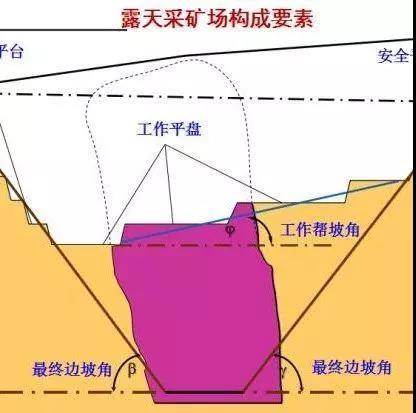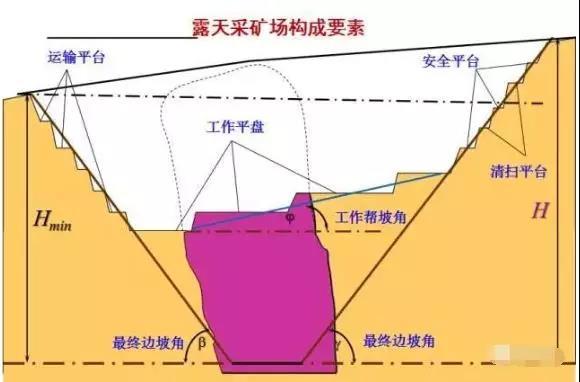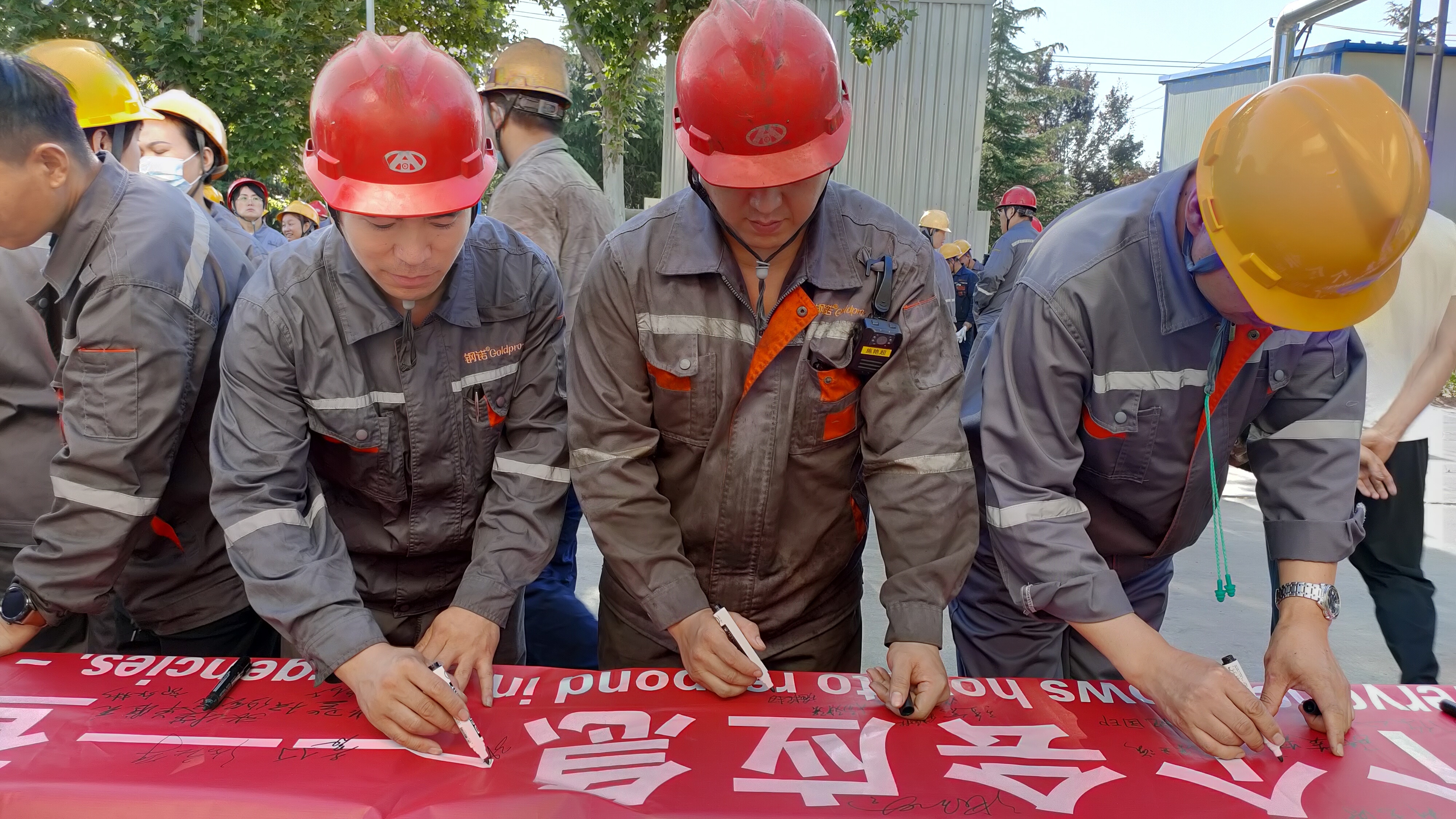Types, prevention, and control of landslides in open-pit mining
Dec 27,2021

I. Constituent Factors of Open-Pit Mine Slopes
Open-pit mining involves dividing the ore into horizontal layers of a certain thickness and extracting them layer by layer from top to bottom. This forms stepped terraces around the open-pit mine, and the slope formed by multiple terraces is the open-pit mine side, or open-pit mine slope.

Open-pit mine slopes consist of steps, upper platform of steps, lower platform of steps, step slope, step slope angle, step height, step crest line, and step bottom line, etc.
Steps can be divided into working platforms, safety platforms, cleaning platforms, and transportation platforms according to their uses. The final slope refers to the slope formed by the steps that have been mined to the final interface. The final slope angle is the angle between the final slope surface and the horizontal plane. 
As the mining depth increases, the height, area, and maintenance time of open-pit mine slopes will increase significantly. Otherwise, slope sliding disasters will become increasingly prominent. Therefore, slope stability is becoming one of the focuses of mine disaster prevention in China.
II. Types of Landslides
Types of slope landslides generally include planar landslides, wedge landslides, circular landslides, toppling landslides, and compound landslides. Planar landslides are the most common type.
III. Causes of Landslides
Slope landslide activity is a phenomenon where rock masses deform and eventually collapse under the action of multiple stresses. The whole process can be divided into three stages: The whole process can be divided into three stages: 
Slope landslides are affected by many factors, mainly divided into the following six aspects.
(1) Unreasonable determination of slope angle: If the slope angle is designed to be too gentle, the slope stability is high, but the stripping work and cost increase, while the slope maintenance cost can be reduced. Increasing the slope angle results in poor stability, reduced stripping work and cost, but it brings about personal and equipment safety hazards.
(2) Influence of geological factors on slopes: Rock masses are composed of various rocks, and various structural planes exist in the rock mass. The distribution and abundance of structural planes in the rock mass affect the stability of the slope rock mass. Many landslide examples show that the sliding surface and edge contour of the landslide body are controlled by the structural planes of the rock mass.
(3) Groundwater in the rock mass: Groundwater can change the physical and mechanical properties of rocks, generating static pressure and buoyancy in the cracks of the rock mass. When groundwater flows in the cracks of fractured rock masses, these fractured rocks will be subjected to dynamic water pressure, thus reducing the stability of the slope.
(4) Blasting effect: The earthquake generated by blasting can open the joints of the rock mass, or even cause the rocks to break, affecting slope stability.
(5) Geometric shape of the slope: In open-pit mining, when the slope angle remains unchanged, the higher the slope, the more unstable it is. When the slope height remains unchanged, the larger the slope angle, the more unstable it is. From the horizontal cross-section, the more slopes there are, the more unstable it is, because slopes that protrude towards the mining area are easily subjected to tension and damage, which is not conducive to slope stability.
(6) Other factors affecting slopes: There are management factors, such as over-excavation of the slope toe, stacking waste rock and equipment on the upper part of the slope, building houses, etc., the influence of weathering, and the influence of seismic activity, which will all reduce slope stability.
IV. Landslide Prevention and Control
1. Reasonably determine the working stage slope angle
During open-pit mining, stripping should be carried out before mining. It is strictly forbidden to excavate the bottom and leave the upper part, which can cause landslides through reckless and risky mining. In the working stage, rock drilling, blasting, loading, and geological surveying are required, and these operations continuously move with the advancement of mining.
The rocks near the slope surface are affected by blasting vibrations, and often cause rock collapse or narrowing of the platform width due to excessive stage slope angles, leading to accidents. Therefore, in the design and production of open-pit mines, it is necessary to determine the appropriate slope angle and specify the minimum working platform width based on the geological conditions of the mine, the mechanical properties of the rocks, and the performance and specifications of various equipment. The stripping, mining, and transportation equipment, power supply and communication lines should be located within the stable slope surface of the working platform.
2. Slope maintenance
Open-pit mine slopes must be regularly inspected and maintained to ensure slope stability and prevent disasters.
Establish a professional slope maintenance team to strengthen inspection and maintenance. If necessary, conduct artificial slope cutting, lay sod, plant shrubs, build local retaining walls, or pre-embed anti-landslide wooden piles.
A drainage network should be set up to prevent surface rainwater from flowing into the mine pit and eroding the slope and lubricating the stratification; deep open-pit mines should set up facilities to block or divert floods and debris flows around the outside of the pit. The drainage network includes the following three parts: surface drainage, underground drainage, and three-dimensional drainage system.
When blasting near the slope, pre-splitting and vibration-reducing blasting methods should be used, reducing the amount of explosives per hole and increasing the number of holes, and reducing the number of blasting holes in each delay blasting to prevent damage to slope stability due to open-pit blasting operations.
3. Anti-sliding engineering and reinforcement methods
Anti-sliding engineering is an indispensable part of preventing landslides, especially for mine slopes that are related to the safety of life and property, its significance is extraordinary.
Anti-sliding engineering includes: Anti-sliding retaining walls, reinforced retaining walls, anchored plate retaining walls, prestressed anchor cable retaining walls, and anchor rod retaining walls.
Anti-sliding piles: Large-section row-type anti-sliding single piles, anti-sliding chains, steel pipe piles, platform-type anti-sliding piles, flood-control piles, pile foundation retaining walls, chair-type retaining walls, frame-type anti-sliding piles, anti-sliding rigid frame piles, sheet pile anti-sliding piles, and anchored piles.
Soil improvement: Grouting, micro-piles.
4. Landslide Monitoring
Monitoring rock displacement can reveal signs of landslides. Groundwater activity below the slope should also be observed using piezometers; seismographs can monitor the impact of blasting vibrations to obtain slope dynamics.
5. Landslide Prevention and Control
Restrict unlicensed mining and strictly prohibit illegal mining; punish the occupation of mountaintops and slopes for mining; prohibit the predatory mining practice of not opening working benches, not stripping, or stripping and mining simultaneously; strictly prohibit the destruction of slope vegetation. Flood control facilities to divert water flow must be set up at the edges of open-pit mines. Mechanically reinforce slopes by installing anchor rods and anchor piles.
During the mining process of open-pit mines, the stability of the slope directly restricts the safety of the mine and is one of the most critical factors affecting the mine's economic benefits. Generally, from the mine's commissioning to the end of mining, the impact of landslides runs throughout the entire process. Therefore, the management of open-pit slopes should continue until the end of mining, and the investment is enormous.







